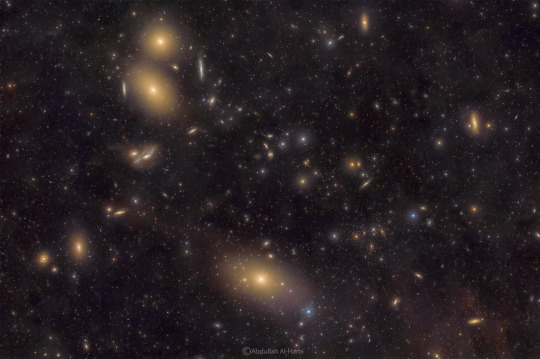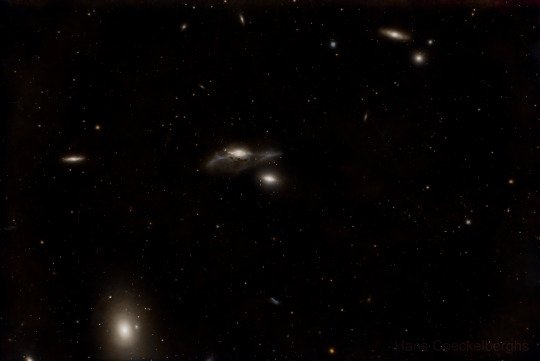#NGC 4438
Text

Markarian's Chain 😐 // Bryan Wilmoth
Some of the galaxies in this image include: M84, M86, NGC 4388, The Eyes (NGC 4438), NGC 4461, and NGC 4458.
#astronomy#astrophotography#galaxy cluster#virgo cluster#galaxy#spiral galaxy#elliptical galaxy#peculiar galaxy#interacting galaxies#eyes galaxies#NGC 4435#NGC 4438#Arp 120#messier#messier 84#M84#messier 86#M86#NGC 4374#NGC 4406#NGC 4388#NGC 4461#NGC 4458#virgo
42 notes
·
View notes
Text
2024 March 20
Two large galaxies are pictured. On the left is a distorted spiral galaxy, while on the right is a relatively featureless yellow disk galaxy. Together, these galaxies may look, to some, like a pair of eyes.

The Eyes in Markarian's Galaxy Chain
Image Credit & Copyright: Mike Selby
Explanation: Across the heart of the Virgo Galaxy Cluster lies a string of galaxies known as Markarian's Chain. Prominent in Markarian's Chain are these two interacting galaxies, NGC 4438 (left) and NGC 4435 - also known as The Eyes. About 50 million light-years away, the two galaxies appear to be about 100,000 light-years apart in this sharp close-up, but have likely approached to within an estimated 16,000 light-years of each other in their cosmic past. Gravitational tides from the close encounter have ripped away at their stars, gas, and dust. The more massive NGC 4438 managed to hold on to much of the material torn out in the collision, while material from the smaller NGC 4435 was more easily lost. The remarkably deep image of this crowded region of the universe also includes many more distant background galaxies.
#astronaut#astronomers#not astrology#star#stars#art#astronomy#outer space#space#artist#eyes#galaxy#galaxies#universe#light years#virgo#the eyes#NGC 4435#NGC 4438#Gravitational tides#cosmic#cosmic past#gas#dust#collision
21 notes
·
View notes
Text
Markarian's Chain
Markarian's Chain of galaxies in Virgo. #astronomy #galaxy #asteroid #virgo
Image exposure:171 MinutesImage Size:1.94º x 1.32ºImage date:2023-04-27
Markarian’s Chain is an astonishing diagonal line of galaxies, beginning with NGC 4473 (top), then NGC 4458 and NGC 4461, then NGC 4435 and NGC 4438, then M85 and M84.
The galaxies belong to the Virgo Cluster of galaxies, a huge conglomeration of over 1,300 galaxies of different types. Twenty-two of them are clearly visible…

View On WordPress
#194 Prokne#amateur astronomy#asteroid#Astronomy#Cosmic Focus Observatory#cosmos#deep sky#Featured#image#M84#M86#M87#Markarian&039;s Chain#nature#NGC 4435#NGC 4438#NGC 4473#photography#science#Skywatcher EQ6-R#Skywatcher esprit 120#space#Universe#Virgo#ZWO ASI071
0 notes
Text

NGC 4438, Markarian's Eyes
697 notes
·
View notes
Photo

2024 March 20
The Eyes in Markarian's Galaxy Chain
Image Credit & Copyright: Mike Selby
Explanation: Across the heart of the Virgo Galaxy Cluster lies a string of galaxies known as Markarian's Chain. Prominent in Markarian's Chain are these two interacting galaxies, NGC 4438 (left) and NGC 4435 - also known as The Eyes. About 50 million light-years away, the two galaxies appear to be about 100,000 light-years apart in this sharp close-up, but have likely approached to within an estimated 16,000 light-years of each other in their cosmic past. Gravitational tides from the close encounter have ripped away at their stars, gas, and dust. The more massive NGC 4438 managed to hold on to much of the material torn out in the collision, while material from the smaller NGC 4435 was more easily lost. The remarkably deep image of this crowded region of the universe also includes many more distant background galaxies.
∞ Source: apod.nasa.gov/apod/ap240320.html
112 notes
·
View notes
Text
Markarian'ın Galaksi Zincirindeki Gözler
Günün Astronomi Görseli 20 Mart 2024
Görsel & Telif: Mike Selby
Başak Galaksi Kümesi‘nin kalbinde Markarian Zinciri olarak bilinen bir galaksi dizisi yer alır. Markarian Zinciri’nde öne çıkan etkileşim halindeki bu iki galaksi, NGC 4438 (solda) ve NGC 4435 aynı zamanda Gözler olarak da bilinir. Yaklaşık 50 milyon ışık yılı uzaklıktaki bu iki galaksi bu keskin yakın çekimde birbirlerinden…

View On WordPress
0 notes
Text
Galaxies of the Virgo Cluster, about 50 million light-years distant, the Virgo Cluster is the closest large galaxy cluster to our own local galaxy group. Prominent here are Virgo's bright elliptical galaxies Messier catalog, M87 at bottom center, and M84 and M86 (top to bottom) near top left. M84 and M86 are recognized as part of Markarian's Chain, a visually striking line-up of galaxies on the left side of this frame.
Near the middle of the chain lies an intriguing interacting pair of galaxies, NGC 4438 and NGC 4435, known to some as Markarian's Eyes. Of course giant elliptical galaxy M87 dominates the Virgo cluster. It's the home of a super massive black hole, the first black hole ever imaged by planet Earth's Event Horizon Telescope.
📷: Abdullah Alharbi

1 note
·
View note
Photo

Virgo Cluster Galaxies via NASA https://ift.tt/GCP6mtS
Galaxies of the Virgo Cluster are scattered across this nearly 4 degree wide telescopic field of view. About 50 million light-years distant, the Virgo Cluster is the closest large galaxy cluster to our own local galaxy group. Prominent here are Virgo's bright elliptical galaxies Messier catalog, M87 at bottom center, and M84 and M86 (top to bottom) near top left. M84 and M86 are recognized as part of Markarian's Chain, a visually striking line-up of galaxies on the left side of this frame. Near the middle of the chain lies an intriguing interacting pair of galaxies, NGC 4438 and NGC 4435, known to some as Markarian's Eyes. Of course giant elliptical galaxy M87 dominates the Virgo cluster. It's the home of a super massive black hole, the first black hole ever imaged by planet Earth's Event Horizon Telescope.
1 note
·
View note
Text
CHANG-ES XXIX: The Sub-kpc Nuclear Bubble of NGC 4438. (arXiv:2205.12343v1 [astro-ph.HE])
AGN bubbles could play an important role in accelerating high-energy CRs and galactic feedback. Only in nearby galaxies could we have high enough angular resolution in multi-wavelengths to study the sub-kpc environment of the AGN, where the bubbles are produced and strongly interact with the surrounding ISM. In this paper, we present the latest Chandra observations of the Virgo cluster galaxy NGC 4438, which hosts multi-scale bubbles detected in various bands. The galaxy also has low current star formation activity, so these bubbles are evidently produced by the AGN rather than a starburst. We present spatially resolved spectral analysis of the Chandra data of the $\sim3^{\prime\prime}\times5^{\prime\prime}$ ($\sim200{\rm~pc}\times350\rm~pc$) nuclear bubble of NGC 4438. The power law tail in the X-ray spectra can be most naturally explained as synchrotron emission from high-energy CR leptons. The hot gas temperature increases, while the overall contribution of the non-thermal X-ray emission decreases with the vertical distance from the galactic plane. We calculate the synchrotron cooling timescale of the CR leptons responsible for the non-thermal hard X-ray emission to be only a few tens to a few hundreds of years. The thermal pressure of the hot gas is about three times the magnetic pressure, but the current data cannot rule out the possibility that they are still in pressure balance. The spatially resolved spectroscopy presented in this paper may have important constraints on how the AGN accelerates CRs and drives outflows. We also discover a transient X-ray source only $\sim5^{\prime\prime}$ from the nucleus of NGC 4438. The source was not detected in 2002 and 2008, but became quite X-ray bright in March 2020, with an average 0.5-7 keV luminosity of $\sim10^{39}\rm~ergs~s^{-1}$.
from astro-ph.HE updates on arXiv.org https://ift.tt/dYPo01L
1 note
·
View note
Photo

Markarian's Chain / سلسلة ماركاريان
#universe#space#galaxy#مجرة#Markarian's Chain#سلسلة ماركاريان#M 84#NGC 4374#M 86#NGC 4406#NGC 4477#NGC 4473#NGC 4461#NGC 4458#NGC 4438#NGC 4435
46 notes
·
View notes
Text

The Eyes Galaxies (center) // Hanzen
#astronomy#astrophotography#galaxy#lenticular galaxy#interacting galaxies#peculiar galaxy#eyes galaxies#Arp 120#NGC 4435#NGC 4438#messier#messier 86#M86#NGC 4406#NGC 4425#NGC 4461#NGC 4458#virgo
46 notes
·
View notes
Text


Markarian's Chain. The middle two are known as The Eyes. 17 galaxies in the Virgo cluster are imaged here. Each on average has 400billion stars. Total is just under 7 trillion stars here!!
#asi120mm#galaxy#zwo#backyard astronomy#neq6#orion#asi1600mm#backyard astrophotography#Markarian's Chain#galaxy clusyter#ngc 4406#ngc 4438#ngc 4374#ngc 4461
2 notes
·
View notes
Photo

Unusual Galaxy
55 notes
·
View notes
Photo

Markarian’s Eyes (NGC 4438 and NGC 4435)
Part of Markarian’s Chain in the Virgo Galaxy Cluster
#Markarian’s Eyes#NGC 4438#NGC 4435#Virgo Galaxy Cluster#nasa#stargazing#astrophoto#astrophotography#galaxy#astronomy#universe#space#nebula#spinningblueball#milky way#milky way galaxy#star
134 notes
·
View notes
Photo

2023 May 26
Virgo Cluster Galaxies
Image Credit & Copyright: Abdullah Alharbi
Explanation: Galaxies of the Virgo Cluster are scattered across this nearly 4 degree wide telescopic field of view. About 50 million light-years distant, the Virgo Cluster is the closest large galaxy cluster to our own local galaxy group. Prominent here are Virgo's bright elliptical galaxies Messier catalog, M87 at bottom center, and M84 and M86 (top to bottom) near top left. M84 and M86 are recognized as part of Markarian's Chain, a visually striking line-up of galaxies on the left side of this frame. Near the middle of the chain lies an intriguing interacting pair of galaxies, NGC 4438 and NGC 4435, known to some as Markarian's Eyes. Of course giant elliptical galaxy M87 dominates the Virgo cluster. It's the home of a super massive black hole, the first black hole ever imaged by planet Earth's Event Horizon Telescope.
∞ Source: apod.nasa.gov/apod/ap230526.html
78 notes
·
View notes
